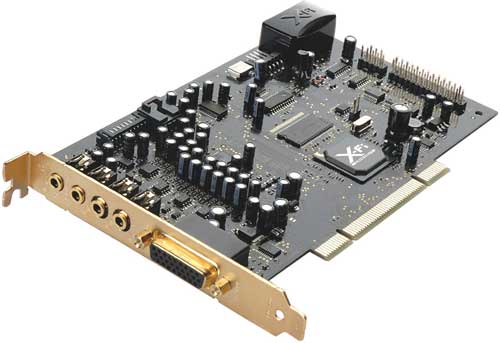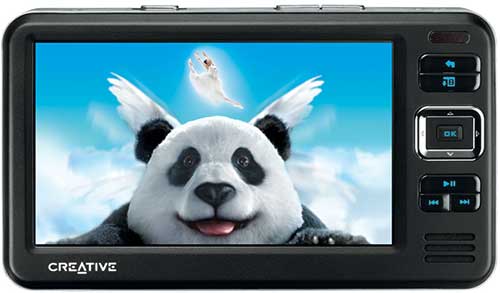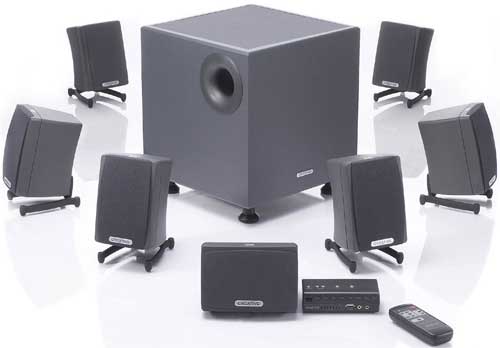The Business of Technology: Creative Labs
by Ryan Smith on October 2, 2007 5:00 PM EST- Posted in
- Bulldozer
Creative's Technology
So what has brought upon these changes in revenue and Creative's overall business problems? The answer to that lies in what's been going on with their technology and individual product market share.
Earlier we called Creative the king of sound cards until recently, much of their business woes stems from that loss. Creative's history is one founded on the back of the Sound Blaster hardware and the Sound Blaster name, creating a problem for Creative in having all of their eggs in one basket that they have been trying to solve for years. All told, Creative hasn't had a lot of luck spreading out their business and doing well; various efforts like graphics cards and DVD-ROM drives never panned out. Of the few things that have panned out, Creative's major consumer product lines have settled in as the following: portable media players, sound cards, webcams, and speakers.
Since sound cards were Creative's biggest business at one point, it has been Creative's biggest loss. Onboard audio has gone from a joke 10 years ago to how the vast majority of computers today handle audio, and it has been Creative who has suffered the greatest losses from that. The Live and Audigy series have both been bonafide successes in terms of sales, but never the less sales are slowing and the X-Fi likely won't be nearly as successful. The fact of the matter is that the consumer sound card market is on its last leg and the possible user base for such hardware has shrunk to professionals and gamers, and that's it.

The X-Fi will likely be the last significant feature-heavy sound DSP to be released by anyone, and it will never match the kinds of sales Creative has seen with earlier products. The final nail in the coffin will be Windows Vista, which as we have discussed in our review of that operating system, under normal circumstances runs the entire audio subsystem in software, reducing the need for a sound card down to a DAC to handle the digital/analog conversion. Creative's own troubles in writing solid Vista drivers for their sound cards hasn't helped matters either, but this has only hastened the inevitable. The sound card is dead, and it isn't coming back.
So what is Creative's leading product with the demise of the sound card? As we saw in their financials, it's now portable media players, a growing market but unfortunately for Creative it's one that they're getting slaughtered in. Prior to the arrival of the iPod, Creative was vying for the top of the portable media player market next to the now-defunct Rio brand, leading to the infamous Slashdot quote about the iPod's release: "No wireless. Less space than a nomad. Lame." Now Creative is struggling in a market where it was one of the first players.

Apple has the vast majority of the North American market for obvious reasons, but #2 tends to be shocking to most people: SanDisk. With Apple's main focus on the mid-to-high end MP3 player market, it has left an opening for cheap media players that SanDisk has been able to fill. Meanwhile both SanDisk and Apple have kept Creative and the other competitors locked out of the market, with Creative taking the #3 spot with less than 4% of the market. Creative's problems are further compounded by Microsoft at #4, who is more than happy to lose money on the media player market for now, and previously backed the PlaysForSure technology that Creative uses for DRM. It should be noted however that Apple doesn't have this kind of penetration in Asia, but as there are no reliable statistics on sales in most Asian markets, we can't ascertain what Creative's exact share there is, but it's believed to still be well below #1.
As a result of all of this, what little share of the market Creative has is almost entirely composed of the near-commodity market, save the small number of "anything but Apple" sales. Their Nomad and Zen lines do not have any significant brand recognition, meanwhile SanDisk can build & sell flash based media players for less than Creative. What little bit of the near-commodity market Creative does have a strong foot in is hard drive based media players that focus on video, and even this is at risk of being undermined by Apple now that they have a full-screen iPod to compete. In spite of all of this the majority of Creative's revenue comes from portable media player sales, but fighting on the near-commodity market means they will never be able to attain much of a profit with it.
Creative's third market segment, webcams, is more or less the same story. Webcams are a commodity - there's a lot of competition and not a lot of money. They may stay in it, but they'll never be able to repeat their most profitable days relying on webcams.
There is one bright spot for Creative however, and that's speakers. In their efforts to branch out Creative picked up Cambridge Soundworks in 1997, and their speaker division has continued to perform well. Creative is only dealing in computer speakers which limits their overall market and they face stiff competition from the likes of Logitech, but this market isn't quite a commodity market like Creative's other major markets. In fact as a percentage of revenue the speaker division is nearly 20%, which is itself nearly twice as much as it was 2 years ago. We'd expect Creative to be pushing their speaker products harder as the sound card market finishes crashing, since even with the integration of audio consumers still need speakers.

Finally there are all of Creative's other markets, which we'll touch on briefly. Creative continues to sell various peripherals, such as mice and routers, but most of these are low-volume products that are simply rebranded products form other suppliers. In fact most readers have probably never seen these products in a local store; Creative's minor product lines are almost exclusively limited to the Asian markets. The profitability from these operations is reportedly decent, but it's not something that Creative can win at in the international markets.










95 Comments
View All Comments
Freddo - Thursday, October 4, 2007 - link
Sometimes I wonder how PC audio would be like if Creative actually made their stuff themselves instead of ripping it out of their dead competitors. We could have cheap, high quality MIDI (E-MU), compatibility with ISA cards (Ensoniq), superior 3D sound (Aureal), and Dolby Digital encoding in hardware (Sensaura), but nooo, Creative had to ruin the fun for everyone, and keep their "monopoly", which now bitten them in the back.I really liked their Sound Blaster cards back in the DOS days, but EAX never impressed me and I've been a very satisfied customer of Terratec cards now for almost a decade.
There are a fair amount of people who will buy the latest Sound Blaster cards just for EAX or simply because it's "the soundcard to have". I'm a member of a few swedish hardware forums, and if a person there ask for soundcard recommendations, everyone will come and yell "Sound Blaster!".
I'm quite grateful for what MS has done, too, with their audio changes. And with Service Pack 1 for Vista they are adding the XAudio2 API which will probably give excellent 3D audio (Xbox 360 uses the XAudio1 API). Sure, it will use the CPU for the audio processing, but that's hardly any issue when dual-cores are the norm, and soon quad-core will be. Which removes the need for EAX, even for the EAX enthusiasts. Unfortunately, Creative pulled a patent stunt on ID software and forced them to add EAX for Doom3, so I guess they might continue to do so.
DDG - Thursday, October 4, 2007 - link
I'd rather see more competition now that ASUS has released their Xonar card. Discrete auido is still a vital component for an enjoyable multimedia experience on the PC and if it dies then you'd best believe that discrete video will be next.lsman - Thursday, October 4, 2007 - link
Thanks for different angles on Technology.I will like to view a follow up of Sound card "creative alternative" for gamers....if you can.
I currently own X-fi gamer and Audigy 2 zs, a creative mp3 player (a Zen before)
Although Audigy 2 has some problem in gaming (could be the game developer or so), its been well in X-fi so far.
jay401 - Thursday, October 4, 2007 - link
It says a lot that many gamers were willing to go with (comparatively) unknown brands for their soundcards when given the opportunity. It tells you just how big a pile of crap Creative's products were and just how little they listened to their customers to address and improve the problem areas.Creative insisted on releasing crap for years, and still often have crap for drivers and software control panels. If they hadn't been so bull-headed and actually listened to the consumer and addressed those issues, one can only guess that they would have done better and competition that cropped up like Turtle Beach, the Diamond Monster Sound MX300, and Auzentech wouldn't have gained the footholds they did because people would have actually been satisfied with their existing Creative products enough to not bother trying another brand. Creative was so bad for a while it actually encouraged other companies to get into the audio peripheral arena who likely would not have otherwise (e.g. Diamond).
jay401 - Thursday, October 4, 2007 - link
By the way, people rating posts down are folks who've never heard of the SoundBlaster16, AWE32, AWE64, etc. Newbs who don't really know Creative's history, just their X-Fi series that is actually decent (aside from a few games where they cause crashes or lockups... classic Creative driver bugs).I do wish Creative well but if they don't shape up, this is really just what they deserve for ignoring customer feedback over the years.
AggressorPrime - Thursday, October 4, 2007 - link
I just started using Creative products when their X-Fi came out. Just when they start having a quality product, they must die? The X-Fi provides numerous advantageous over onboard sound. Battlefield 2142 sounds so much better with full EAX 5.0. Of course, I know only gamers along with music enthusiasts will support X-Fi, since people might see it as a pain to hand over $100 for a quality audio experience. All Creative needs to do is then force people to use their product. What I mean by this is do what they are doing with onboard audio and MSI with everybody: every motherboard, whether desktop or notebook, oem or retail, DIY or Dell should have an X-Fi. Even better is if they can make a deal with nVidia and put X-Fi's on their video cards in order to compete with AMD's audio chip on their video cards. Then their HDMI would be better than AMD's considering the audio quality would be so ahead. And don't put on a cut down version on the motherboard or the video card. Put on the full fledge version and charge the mobo manufacturer / video card manufacturer $20 for the chip and X-RAM. Sure, you lose per product sale (considering you could've made $100), but you gain because everything uses your product. Moreover, you still make a profit $20/chip. If I saw an X-Fi Elite chip on a notebook, I know I would heavily consider getting it (since all Creative does for notebooks now is waste an ExpressCard bay for XtremeAudio, but since I got it I still think it's worth it for the serious gamer/movie/sound lover, even in Vista).deptmaster - Thursday, October 4, 2007 - link
With the advent of HDMI Creative should be licensing their audio chips to video card manufacturers or if possible get into the video card market themselves.jmurbank - Thursday, October 4, 2007 - link
The sound card business is slow and coming to a stop because nobody cares for quality sound. I rather have sound quality, but not from Creative Labs because what things happened in the past. I think my first sound card is created by Voyetra. I bought a Creative Labs Soundblaster LIVE! in 2000 thinking it was the best, but it was not. The sound quality of the card after I changed it to a Turtle Beach Santa Cruz was worst. The Santa Cruz had better sound quality and it did not hurt the bus that the LIVE card likes to do. My next sound card is Audiotrak Prodigy 7.1 which has equal sound quality compared to the Lynx Studio Technology LynxTWO.The E-Mu is a fantastic DSP chip, but Creative Labs only went for numbers instead of sound quality. If a better company used the E-Mu chip, it will be a lot better than what Creative Labs did to it.
An discrete sound card and graphics is necessary to include special features that a motherboard does not have. These discrete boards provides extreme performance that motherboard manufactures skim or cut corners to sell their boards at low prices. Discrete boards will always be in when people want very, very high quality graphics with the highest frame rates and the very best sound that a motherboard can not do.
From what I learn over the years from the sound industry. A company have to have a distinct audio tone, so that it can survive. The tone that Creative Labs is playing is more machine than an actual tone. A machine tone is not very attractive. There is a sweet, dynamic, warm, etc tones that different people like. These tones attract people to certain music artist and audio manufactures.
grantschoep - Wednesday, October 3, 2007 - link
Sorry bought that half post, fingers hitting keys a too fast rate.I've always hated that I had a Soundblaster Live!, its decent, but it was just the Soundblaster name. Any one who gamed in DOS, in the early/middle 90s, that had the Gravis Ultrasound sound card, knows what I am talking about. It totally blew away the sound quality/features of anything else. Playing Doom, was awesome. 32 stereo voices... my favorite quote "SBOS installed"(which when the Soundblaster emulator started up, the driver said this on boot.
Sure there was a few kinks to work on in the drivers, but then this was DOS, what product did have some kinks. They were good about updating software. I remember dialing via modem in long distance(to Canada from the US) to update drivers.
Anyways, competition is always good. Hey, Gravis really kicked Soundblaster's butt when it came to features. The Ultrasounds 32 stereo voices vs Soundblaster 4 voice mono, was the comparison at at time.
I think Creative should really focus on a very good power effiecent, cool processor for sound. I really don't think that many people run 7.1 audio from their computer(our home theater systems actually, since few movies even support that)
Give me a good, fast, power efficient, 2.0 stereo sound processor. Get the sound as clean as possible(low THD). I'll buy. My $2500 dollars of B&W Speakers is attached to my home theater. My 30 dollar 2 speaker/sub is attached to my computer.
Schugy - Wednesday, October 3, 2007 - link
Who needs Creative if there's no open ALSA driver for their sound cards? Who needs sound cards with disabled digital connectors because everybody is supposed to be a pirate? Who needs players with MS DRM instead of gapless ogg vorbis support? Who buys an X-Fi for PCI if there are rumors about a PCIe version of it? Ever heard of competitors products like Noxon or Soundbridge or maybe Evoke? We all like digital radio like DAB, DMB or internetstreams but who still buys FM radios? Well, digital users might become victims of encryption but I would boycott digital radio in that case :-)